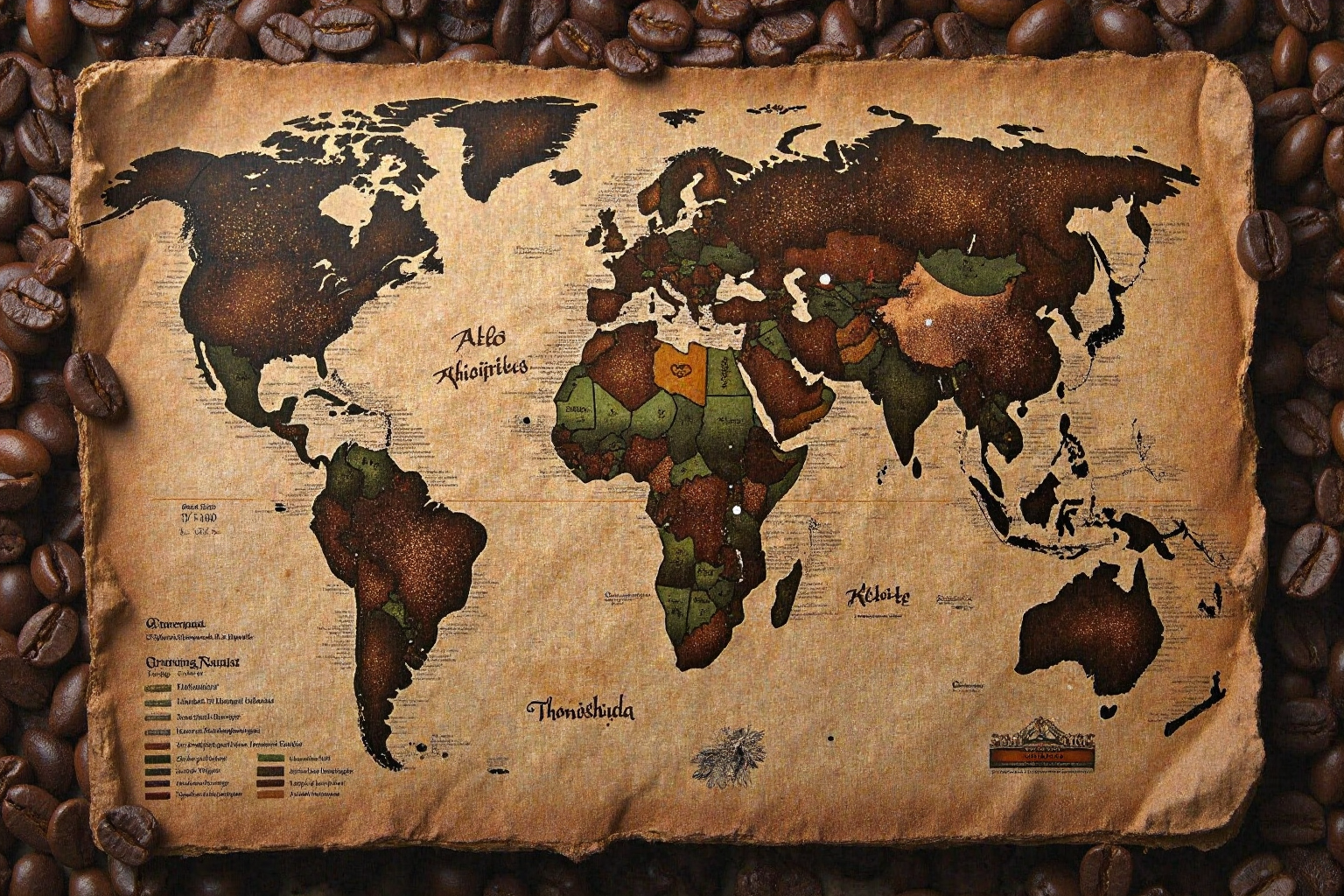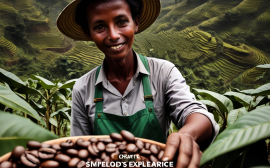A World in Every Cup: Unveiling the Global Coffee Bean Origin Atlas 2025
The aroma of freshly brewed coffee, a ritualistic comfort for billions, often masks a complex global story of interconnected economies, environmental stewardship, and cultural heritage. From the misty highlands of Ethiopia, where the Arabica bean first took root, to the volcanic slopes of Indonesia, where unique processing methods yield earthy and complex flavors, the journey of a coffee bean is a testament to human ingenuity, agricultural innovation, and the ever-present challenges of a changing world.
This journey is more than just beans changing hands; it’s a narrative of global trade, sustainable development, and the pursuit of the perfect cup. The ‘Global Coffee Bean Origin Atlas 2025’ aims to demystify this intricate journey, providing a detailed exploration of the world’s major coffee-producing regions, their unique flavor profiles, and the sustainable practices shaping the future of coffee. Consider the delicate floral notes of a Yirgacheffe, a testament to Ethiopia’s unique terroir and the meticulous work of smallholder farmers.
Or the rich chocolate and caramel undertones of a Colombian Supremo, reflecting the country’s long-standing coffee tradition and commitment to quality. These diverse flavor profiles are not mere accidents of nature but the result of specific geographical conditions, cultivation practices, and processing methods. Understanding these factors is crucial for both coffee enthusiasts seeking to expand their palates and industry professionals striving to source ethically and sustainably. This Atlas serves as a guide to navigating the complex landscape of coffee origins, offering insights into the distinct characteristics of each region and the challenges they face.
Sustainability is no longer a niche concern but a critical imperative for the future of coffee. As climate change intensifies, impacting rainfall patterns and increasing the prevalence of pests and diseases, coffee-growing regions around the world are facing unprecedented challenges. From promoting shade-grown coffee to implementing water-efficient irrigation techniques, farmers are adopting innovative strategies to mitigate these risks and ensure the long-term viability of their crops. This Atlas highlights these sustainable practices, showcasing the efforts of farmers, cooperatives, and organizations working to protect the environment and build a more resilient coffee industry.
The choices consumers make, from supporting fair trade certified coffee to reducing their environmental footprint, play a vital role in shaping this future. By understanding the origin of their coffee and the challenges faced by producers, consumers can make informed decisions that support both quality and sustainability. The specialty coffee market, driven by a growing appreciation for nuanced flavors and ethical sourcing, is also transforming the coffee landscape. Consumers are increasingly seeking out single-origin coffees and exploring the diverse flavor profiles offered by different regions.
This demand for high-quality, sustainably produced coffee is creating new opportunities for farmers and incentivizing the adoption of environmentally friendly practices. The ‘Global Coffee Bean Origin Atlas 2025’ provides a valuable resource for navigating this evolving market, offering insights into the unique characteristics of each coffee-producing region and the factors that contribute to their distinctive flavors. From the bright acidity of a Kenyan AA to the full-bodied earthiness of a Sumatran Mandheling, the world of coffee offers a rich tapestry of flavors waiting to be discovered.
This Atlas serves as a guide to exploring this global mosaic, empowering both consumers and industry professionals to appreciate the complex journey from bean to cup. Finally, the Atlas acknowledges the geopolitical factors influencing the coffee trade. From fluctuating global market prices to trade agreements and government regulations, these forces have a profound impact on the livelihoods of coffee farmers and the sustainability of the industry. Understanding these complex dynamics is essential for fostering a more equitable and sustainable coffee trade that benefits both producers and consumers. This Atlas provides a framework for understanding these global influences and their impact on the coffee landscape, promoting transparency and informed decision-making within the industry.
Ethiopia: The Cradle of Coffee and its Fragile Future
Ethiopia, the birthplace of Arabica coffee, holds a revered position in the global coffee landscape, offering a captivating array of flavor profiles that reflect its diverse terroir. From the bright, floral, and citrusy notes characteristic of Yirgacheffe to the berry-like sweetness and rich chocolate undertones found in Sidamo, Ethiopian coffees offer a sensory journey for discerning palates. These distinct characteristics are largely attributed to the country’s high altitudes, unique microclimates, and the rich volcanic soils that nourish the coffee plants.
Smallholder farmers, often organized into cooperatives, form the backbone of Ethiopia’s coffee industry, employing traditional farming methods passed down through generations. These time-honored practices, often involving shade-grown coffee and minimal intervention, contribute to the beans’ complex flavor profiles and promote biodiversity within the coffee forests. However, this vital sector faces mounting challenges, including the increasing threat of climate change. Rising temperatures, erratic rainfall patterns, and the increased prevalence of coffee leaf rust are impacting both yields and bean quality, jeopardizing the livelihoods of millions who depend on coffee cultivation.
Addressing these challenges requires a multi-pronged approach. Sustainable farming practices, such as agroforestry and water conservation techniques, are crucial for mitigating the effects of climate change and ensuring the long-term viability of coffee production. Furthermore, certifications like Fair Trade and Rainforest Alliance play a vital role in promoting ethical sourcing, ensuring fair prices for farmers, and supporting community development projects. These certifications provide consumers with a way to make informed choices that align with their values and contribute to a more equitable coffee trade.
The Ethiopian Commodity Exchange (ECX), established to modernize and standardize the coffee trade, has played a significant role in connecting farmers with global markets. However, it has also faced criticism for its impact on traceability and farmer autonomy. Some argue that the ECX’s system, which prioritizes volume and standardization, can obscure the unique characteristics of specific coffee origins and limit farmers’ ability to directly negotiate prices and build relationships with buyers. The future of Ethiopian coffee hinges on balancing the need for increased market access and economic development with the preservation of traditional farming practices, biodiversity, and the unique flavor profiles that make Ethiopian coffees so prized.
Investing in research and development, promoting sustainable farming techniques, and strengthening farmer cooperatives are crucial steps towards ensuring a vibrant and sustainable future for Ethiopian coffee and the communities that depend on it. Supporting initiatives that prioritize traceability and farmer empowerment can also help ensure that the rich heritage of Ethiopian coffee continues to thrive for generations to come. The global coffee community has a vested interest in supporting the sustainable development of Ethiopia’s coffee sector, recognizing its crucial role in preserving biodiversity, promoting economic stability, and safeguarding the future of one of the world’s most beloved beverages. By understanding the complexities of the Ethiopian coffee landscape, consumers can make informed choices that contribute to a more equitable and sustainable coffee future.
Colombia: Mild Beans, Strong Traditions, and New Challenges
Colombia, a nation synonymous with mild and balanced Arabica beans, owes much of its coffee character to the Andes Mountains and the consistent rainfall that nourishes its coffee-growing regions. The country’s topography, a tapestry of high-altitude slopes and fertile valleys, creates diverse microclimates that shape the nuanced flavor profiles of Colombian coffee. From the caramel and nutty notes of Antioquia to the chocolatey undertones of Huila and the delicate sweetness found in Nariño, each region offers a unique expression of Colombian Arabica.
The ‘Colombia Coffee Growers Federation’ (FNC), a powerful force in the global coffee industry, plays a crucial role in supporting coffee farmers, promoting sustainable agricultural practices, and ensuring the quality and consistency that have made Colombian coffee a household name. The FNC’s initiatives, such as the ‘100% Colombian Coffee’ program, aim to protect the integrity of Colombian coffee in a market increasingly flooded with blends and imitations. This program not only guarantees authenticity but also empowers consumers to make informed choices that support sustainable farming practices and fair trade principles.
However, the Colombian coffee industry faces a confluence of modern challenges, including an aging coffee tree population, labor shortages exacerbated by rural-urban migration, and the unpredictable impacts of climate change. These challenges necessitate innovative solutions and collaborative efforts to ensure the long-term viability of Colombian coffee production. The FNC is actively engaged in research and development, promoting disease-resistant varietals, and providing technical assistance to farmers to adapt to changing climatic conditions. Furthermore, the increasing global demand for specialty coffee presents both an opportunity and a challenge for Colombian coffee growers.
While the specialty market allows farmers to command premium prices for their exceptional beans, it also requires meticulous attention to quality control, processing methods, and traceability. Colombian farmers are increasingly adopting innovative post-harvest practices, such as honey processing and anaerobic fermentation, to enhance the complexity and distinctiveness of their coffees, catering to the discerning palates of specialty coffee consumers. This pursuit of quality and differentiation is crucial for Colombia to maintain its competitive edge in the global coffee market and secure the livelihoods of its coffee-growing communities. The intersection of global trade dynamics, sustainable agriculture, and the evolving consumer preferences for high-quality coffee makes the Colombian coffee industry a compelling case study in the complexities of the global food system. As consumers become increasingly aware of the origins and stories behind their coffee, Colombia’s commitment to quality, sustainability, and social responsibility will continue to resonate with those seeking a cup that reflects both exceptional flavor and ethical production.
Sumatra: Earthy Flavors, Environmental Concerns, and Government Influence
Sumatra, Indonesia, an island renowned for its biodiversity and lush rainforests, holds a unique position in the world of specialty coffee. The island’s volcanic soil, coupled with its humid climate and unique processing methods, imparts distinct earthy and full-bodied flavors to its coffee beans, often described with notes of spice, cedar, and tobacco. These beans, primarily Arabica varietals, are frequently processed using the ‘Giling Basah’ (wet-hulled) method, a technique particular to Indonesia. This method, which involves removing the parchment skin of the coffee cherry while it’s still moist, contributes significantly to the coffee’s low acidity and heavy body, a characteristic highly prized by certain coffee enthusiasts.
Regions like Aceh, Lintong, and Mandheling, each with its own microclimate and terroir, produce some of the world’s most sought-after Sumatran coffees, prized for their distinctive flavor profiles. Aceh Gayo, for instance, is known for its clean, bright acidity that balances its earthy notes, while Lintong exhibits a more classic Sumatran profile with pronounced herbal and spice notes. Mandheling, often considered the benchmark Sumatran coffee, delivers a rich, syrupy body with complex flavors of dark chocolate and cedar.
However, the pursuit of these prized beans presents significant environmental and social challenges. Deforestation due to expanding palm oil plantations and unsustainable farming practices threatens the delicate ecosystem that supports coffee cultivation and the island’s unique biodiversity. The delicate balance between coffee production and environmental preservation is further complicated by land rights issues, often leaving smallholder farmers vulnerable to exploitation. Organizations like the Rainforest Alliance and the Sustainable Coffee Challenge are working to mitigate these challenges by promoting sustainable coffee farming practices, such as agroforestry and shade-grown coffee, which not only protect the environment but also improve the livelihoods of local communities.
These practices aim to preserve biodiversity, reduce deforestation, and improve water quality, ensuring the long-term viability of coffee production in Sumatra. The Indonesian government’s policies on land use and resource management also play a crucial role, influencing how coffee is grown and its impact on the environment. Balancing economic development with environmental protection is a complex task, and government initiatives that incentivize sustainable practices are essential. The increasing global demand for specialty coffee, including the unique profiles of Sumatran beans, further complicates the situation. This demand puts pressure on farmers to increase production, potentially leading to unsustainable practices if not managed carefully. Promoting responsible sourcing and consumer awareness about the environmental and social costs of coffee production are vital steps in ensuring the future of Sumatran coffee and the well-being of the communities that cultivate it.
The Global Mosaic: Other Key Coffee-Producing Regions
Beyond the established powerhouses of Ethiopia, Colombia, and Sumatra, a diverse tapestry of coffee-producing regions contributes significantly to the global coffee landscape. Brazil, the world’s largest coffee producer, leverages its vast land resources for large-scale production, primarily focusing on Arabica beans with nutty and chocolatey profiles. However, this focus on volume often comes at the expense of nuanced flavor profiles, and the industry faces ongoing sustainability challenges related to water resource management and deforestation. Vietnam, the second largest global producer, dominates the Robusta market, prized for its use in espresso blends and instant coffee.
This production, while economically significant, faces environmental concerns due to heavy fertilizer and pesticide use, impacting water quality and local ecosystems. Addressing these issues is crucial for the long-term health of Vietnam’s coffee industry and its environment. Central American countries like Guatemala and Costa Rica, known for their high-quality Arabica beans, are increasingly focusing on sustainable practices. These nations often employ shade-grown methods, promoting biodiversity and reducing the need for chemical inputs. Furthermore, organizations like the Rainforest Alliance certify farms committed to sustainable agriculture, providing consumers with ethically sourced coffee options.
African nations such as Kenya and Rwanda are rapidly gaining recognition for their complex and nuanced coffees. Investments in improved processing techniques, like washed and honey processing, and rigorous quality control have elevated their beans to specialty-grade status, commanding premium prices in the international market. This focus on quality has empowered smallholder farmers and contributed to economic growth in these regions. The burgeoning specialty coffee market has created new opportunities for smaller producing regions to showcase their unique beans and terroir-driven flavors.
Countries like Burundi, with its Bourbon varietals grown on volcanic slopes, and Panama, known for its Geisha coffee with its distinctive floral and citrus notes, are attracting discerning coffee connoisseurs willing to pay top dollar for exceptional quality. However, these emerging regions often face significant challenges related to market access, infrastructure development, and access to finance, hindering their ability to fully capitalize on the growing global demand for specialty coffee. Supporting these regions through fair trade practices, direct trade relationships, and investment in local infrastructure is crucial for ensuring the continued diversification and resilience of the global coffee supply chain.
Looking Ahead: Sustainability, Challenges, and the Future of Coffee
The Global Coffee Bean Origin Atlas 2025 reveals the intricate interplay of geography, climate, farming practices, and the resulting flavor profiles, offering valuable insights for both coffee aficionados and industry professionals. Understanding these interconnected factors is crucial for navigating the complex landscape of coffee production and consumption. From the Ethiopian highlands, the birthplace of Arabica coffee, to the volcanic slopes of Sumatra, where earthy Robusta beans thrive, the journey of each bean tells a unique story.
Sustainable farming practices are not merely a trend but a necessity for the long-term viability of coffee production. These practices, encompassing responsible water management, soil conservation, and biodiversity protection, are essential for safeguarding the environment and the livelihoods of millions of coffee farmers worldwide. Consumers play a vital role in supporting these efforts by choosing certified coffees, such as Fairtrade or Rainforest Alliance, and patronizing brands committed to ethical sourcing and transparent supply chains. The challenges facing coffee-producing regions are multifaceted, ranging from the unpredictable impacts of climate change, such as erratic rainfall patterns and increased pest infestations, to the volatile nature of global coffee markets.
These issues demand collaborative solutions involving governments, non-governmental organizations (NGOs), and private sector actors. For instance, the Colombian Coffee Growers Federation (FNC) has implemented programs to support farmers in adapting to climate change and improving coffee quality. Similarly, initiatives in Ethiopia are focused on strengthening cooperatives and promoting sustainable farming practices to enhance the resilience of smallholder farmers. The increasing global demand for specialty coffee, with its emphasis on distinct flavor profiles and origin characteristics, presents both opportunities and challenges.
While it can empower farmers and drive higher prices, it also necessitates rigorous quality control and traceability throughout the supply chain. Consumers’ growing appreciation for the nuances of coffee, from the floral notes of Ethiopian Yirgacheffe to the chocolatey undertones of Colombian Supremo, further underscores the importance of understanding coffee origins and supporting sustainable practices. Resources such as the Specialty Coffee Association (SCA) and the International Coffee Organization (ICO) provide valuable information and research on coffee production, trade, and sustainability.
Furthermore, academic journals and research institutions delve into the scientific aspects of coffee cultivation, processing, and flavor development, contributing to a deeper understanding of this complex beverage. In the realm of global affairs, the influence of major consuming nations, such as the People’s Republic of China (PRC), plays a significant role. While the PRC’s direct policies on coffee production are limited, its investment and trade relationships with coffee-producing countries can have substantial impacts, both positive and negative.
Investments in infrastructure and agricultural technology can boost productivity and improve market access for farmers. However, careful consideration must be given to ensuring equitable partnerships and mitigating potential risks, such as environmental degradation and social disruption. Ultimately, the future of coffee hinges on a collective commitment to sustainability, innovation, and collaboration across the entire value chain. By embracing responsible practices, supporting ethical sourcing, and fostering greater transparency, we can ensure that the beloved ritual of coffee continues to thrive for generations to come.



